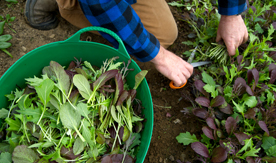
UMaine Student-Run Greenhouse Growing Greens for Campus Dining Halls
Snowflakes floated toward the frozen ground while University of Maine students snipped salad greens inside a campus greenhouse where the temperature approached a balmy 50 degrees.
The greens were a hit with salad bar customers the next day at Maine Marketplace in Memorial Union.
Sonja Birthisel, a graduate student in the sustainable agriculture program, said the red, blue and green leafy mix was tasty and mild. Megan Berthiaune, a senior from Eddington, Maine, majoring in nutrition, described the Elegance Greens Mix as fresh and appealing.
It would have been difficult for the greens to be any fresher or local; they traveled a mere half-mile from the greenhouse to the salad bar.
The Elegance Greens Mix, which includes Pac Choi, red mustard, mizuna and leaf broccoli, was the first harvest of the UMaine Greens Project, supervised by Eric Gallandt, associate professor of weed ecology and chairman of the Department of Plant, Soil and Environmental Sciences.
Gallandt says the inspiration to start a student greenhouse project came from visiting Michigan State University last year. UMaine’s project, which involves growing greens for the UMaine dining commons, builds on the university’s Sustainable Agriculture Program.
UMaine Greens, headquartered in a greenhouse off Rangeley Road, was funded with $11,500 from UMaine’s Unified Fee.
“I wanted to do something where sustainable agriculture students and students interested in local foods, and food enthusiasts could have a hands-on experience,” Gallandt says.
More than $7,700 was invested in a 26-foot by 96-foot greenhouse, purchased from a farmer in New Hampshire.
Gallandt also purchased a piece of equipment he initially didn’t dream he would need — a snowblower to prevent buildup around the double-layer plastic walls of the greenhouse. (He got it on sale in July.)
Daniel Blanton, a senior majoring in sustainable agriculture from Stow, Mass., one of the 25 students involved in the UMaine Greens Project, helped build the greenhouse.
“It was like a really big puzzle,” he says. “This has been one of my favorite experiences at UMaine. Hoop houses are the future in Maine for sustainable farmers. Winter production is exciting.”
In September, project participants had a “greenhouse raising”; they gathered at 7 a.m. one calm Friday to pull the two layers of plastic over the metal tubing frame.
Oct. 12, students planted rows of Johnny’s Selected Seeds, and Nov. 29, about 20 pounds of the tasty greens crop became lunchtime salad bar fare for students and staff.
The idea of growing and eating healthy, local food is logical and appealing to many in the college community, Gallandt says. Frequent themes in agriculture classes include reducing the number of food miles — the distance food travels to reach the table — and the ability to control and extend the growing environment. This project addresses both topics in a hands-on, positive manner, he says.
And there is room, literally, to grow.
“It might not be possible to feed the campus, but we can plant one bed of greens at a time, so to speak,” Gallandt says.
Glenn Taylor, director of Maine Culinary Services and a champion of the UMaine Greens Project, says 15 percent of all food served in campus dining halls is harvested at Maine farms from meat to beets. That equates to the university spending $700,000 annually with area businesses.
Taylor says in two years, the goal is to increase the proportion of locally grown food served at the university to 25 percent.
Purchasing vegetables from the UMaine Greens Project won’t displace any other local grower, Taylor says, and will help the project become financially self-sustaining.
“We focus on local foods and this is about as local as you can possibly get,” says Taylor, carrying a tote of just-clipped salad greens to his vehicle.
Gallandt says it’s also fitting the greenhouse is adjacent to the university’s new composting facility. Compost from the vegetables that feed the students will subsequently nourish the greenhouse soil where the greens are grown.
“It’s symbolic,” he says. “It’s a visual closed nutrient system. Each year, we can use compost to amend the soil.”
Interested students are invited to join the current motivated group of volunteers participating in the project.
“We’re always looking for more help,” said Rose Presby, a fifth-year biology major from Farmington, Maine. “If you’re looking for local food and you care where it comes from, you should definitely get involved,” she said.
Garth Douston, a junior from Arundel, Maine, says there are many benefits to digging in and taking part.
It’s a great opportunity to learn about winter production and extending the growing season and keeping plants alive and thriving,” says Douston, a sustainable agriculture major.
Lincoln, Maine native Bourcard Nesin had a hand in keeping the greens growing this fall. He earned a bachelor’s degree in sustainable agriculture from UMaine last spring and says he’s pleased that students are contributing to the university’s reputation as a healthy campus.
In 2011 and 2012, UMaine was one of 16 colleges nationwide named to The Princeton Review’s Green Honor Roll.
In addition to getting hands-on farming skills, growing healthy, local food, and helping the environment, Gallandt said a greenhouse is simply an inviting place to be.
“Last Sunday, it was 32 degrees and the wind was howling,” he said. “Inside the greenhouse, it was 54 degrees and there was 85 percent humidity. You can’t help but get happy in a place like that.”
Contact: Beth Staples, 207.581.3777
